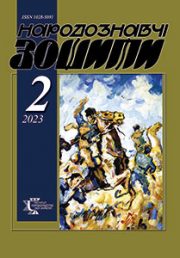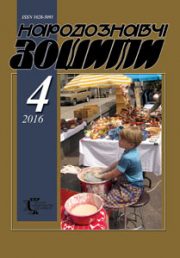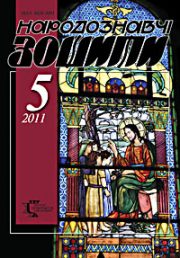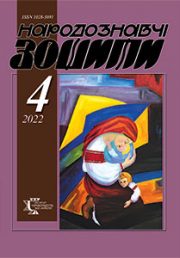The Ethnology Notebooks. 2024. № 4 (178), 901—925
UDK [[745.51+730]:[726:271-526.2]](477.8)”165/185″
DOI https://doi.org/10.15407/nz2024.04.901
ZHYSHKOVYCH Volodymyr
- ORCID ID: https://orcid.org/0000-0003-2699-4907
- Ph.D., Senior Researcher
- The Institute of Ethnology
- of the National Academy of Sciences of Ukraine,
- Department of Art Studies,
- 15, Svobody Avenue, 79000, Lviv, Ukraine,
- Contacts: е-mail: zhyshko@i.ua
Abstract. The article examines the architectural, structural, artistic-plastic, and thematic features of the formation of iconostasis in the churches of Western Ukraine during the period from the second half of the 17th century to the 19th century. Starting from the mid-16th century and throughout subsequent periods, the churches of the Eastern tradition gradually introduced the carving of wooden iconostases, in which the decor evolved from low, almost planar relief to high relief with dynamic form development.
In the mid-17th century, new schemes of modifying iconostases were gradually introduced in the churches of the Eastern Christian tradition, incorporating round sculpture into the structure in addition to icons and intricate openwork carving. The new principles of forming iconostases were most vividly manifested in the territories of Western Ukraine, particularly in Galicia, where the Western European Catholic-Latin artistic spatial-plastic tradition left the most significant trace in the churches of the Eastern rite, resulting in the emergence of a number of original and unique ensembles.
Many researchers have addressed the development of iconostases in the territories of Western Ukraine, but mostly attention has been focused on specific aspects of architectural-plastic and stylistic solutions or, conversely, on outlining a generalized picture of the evolution of the organization of the space in front of the iconostasis with emphasis on the pictorial-iconographic component. The need for a more thorough study of the symbiosis of construction, relief carving, round sculpture, and the thematic resolution of iconostases in the Eastern rite churches of Western Ukraine highlights the relevance of the proposed research.
The purpose of the article is not only to overview the resolution of several main compositional schemes of architectural-plastic solutions of iconostases in Western Ukrainian churches but also to examine in detail the symbiosis of traditional Eastern Christian iconostasis with round sculpture and high relief carving. It aims to outline the main themes, stylistic features, and iconographic content of iconostases with sculpture. Additionally, it aims to identify the role of contemporary renowned sculptors who were influenced by the Western European Catholic-Latin church altar sculpture in introducing new trends in the arrangement of iconostases in churches in Western Ukraine.
The object of the research is relief carving and sculpture in the decoration of iconostases in Western Ukrainian churches during the second half of the 17th to the 19th centuries. The subject of the study is the peculiarities of architecture, stylistic, artistic-plastic, and thematic content of iconostases in Western Ukrainian churches, created in the context of the development trends of contemporary European religious art.
Keywords: church, iconostasis, style, sculpture, relief carving.
Received 17.06.2024
REFERENCES
- Voznyts’kyj, B.H. (2005). Mykola Pototskyi, the elder of Kanivskyi and his artists, the architect Bernard Meretyn and the bricklayer Ioan Georgy Pinzel. L’viv [in Ukrainian].
- Stets’ko, V. (2013). Representation of the work of Ioann-Georhiy Pinzel in the collection of the Ternopil Regional Museum of Local Lore. Collection of works of the Ternopil city branch of the Scientific Society named after T.G. Shevchenko. Museums of the Ternopil Region (Vol. 8, pp. 476—495). Ternopil [in Ukrainian].
- Yurkevych, Yu. (Ed.). (2012). The royal doors of the Ukrainian iconos-tasis. Album. Lviv [in Ukrainian].4. Vujtsyk, V. (1998). Sculptor Ivan Shchurovsky. Notes of the Shevchenko Scientific Society. Proceedings of the Commission of Fine and Applied Arts (Vol. CCXXXVI, pp. 305—319). L’viv [in Ukrainian].
- Sydor, O.F. (1991). The evolution of the Ukrainian baroque iconostasis. Art studios (Part 1, pp. 28—34). L’viv [in Ukrainian].
- Vujtsyk, V. (1998). Krasnopuschan iconostasis of Vasyl Petranovich. Notes of the Shevchenko Scientific Society. Proceedings of the Commission of Fine and Applied Arts (Vol. CCXXXVI, pp. 408—416). L’viv [in Ukrainian].
- Vujtsyk, V. (2004). Monastery of St. Nicholas ChSVV in Krehov. Bulletin of the «Ukrzakhidproekrestavratsiya» hinstitute (Part 14, pp. 194—227). L’viv [in Ukrainian].
- Drahan, M. (1970). Ukrainian decorative carving of the 16th—18th century. Kyiv [in Ukrainian].9. Aleksandrovych, V.S., & Rychkov, P.A. (2008). St. George’s Cathedral in Lviv. Kyiv [in Ukrainian].
- Vujtsyk, V.S. (1979). Lviv State Historical and Architectural Reserve. L’viv [in Ukrainian].
- Vujtsyk, V. (2004). Architectural ensemble of the Assumption Brotherhood. Restoration and renewal. Volodymyr Vuytsyk. Selected works. To the 70th anniversary of the birthday. Bulletin of the «Ukrzakhidproekrestavratsiya» institute (Part 14, pp. 36—42). L’viv [in Ukrainian].
- Voznytskyi, B. (1996). Iconostasis of the Basilian churches in Podhorce. The art of the eastern borderlands: Materials of a scientific session, Krakow, May 1995 (Vol. 2, pp. 366—367). Krakow [in Poland].
- Sydor, O. (1999). A significant milestone of Ukrainian engraving. Galician Gate, 1—2 (49—50), 18 [in Ukrainian].
- Slobodian, V. (2012). Church of the Assumption of the Holy Mother of God. Sights of Ukraine, 2—3 (172—173), 16—23 [in Ukrainian].
- Lahutenko, O. (2003). National Art Museum of Ukraine. Album. Kyiv [in Ukrainian].
- Zhyshkovych, V. (2006). Iconostasis of the Church of St. Nicholas in Zolochiv. Ukrainian Greek Catholic Church and religious art (historical experience and contemporary problems). Scientific collection (Vol. 4, pp. 120—126). L’viv [in Ukrainian].
- Lohvyn, H.N. (1968). Across Ukraine. Ancient art monuments. Kyiv [in Ukrainian].
- Yelisieieva, T. (2010). Decorative decoration and iconography of the royal gate in the collection of the Volyn Regional History Museum. Bulletin. Information publication of the Lviv branch of the National Research and Restoration Center of Ukraine, 11, 57—61 [in Ukrainian].
- Odrekhivskyi, R.V. (2006). The plot of the Tree of Jesse in the decorative carvings of the church interiors of Halychyna. Scientific bulletin of NLTU of Ukraine: Symbol of the tree in world culture and artistic creativity (Vol. 16.4, pp. 114—119). L’viv [in Ukrainian].
- Kosiv, R. (2019). Icons on canvas «The Tree of Yesee» of the second half of the 17th century from the collection the National Museum in Lviv named after Andrey Sheptytsky in the context of subject development. The Ethnology Notebooks, 6 (150), 1379—1392 [in Ukrainian].
- Otkovych, T. (2010). Art studies of the iconostasis from the church of the Archangel Michael Cathedral in the village of Humnysko (XVII—XIX centuries) and attempts at its attribution. Bulletin. Information publication of the Lviv branch of the National Research and Restoration Center of Ukraine, 11, 129—138 [in Ukrainian].
- Svientsitska, V. (1967). Dictionary of Zhovkva masters of painting and carving. Ukrainian art history (Vol. 1, pp. 135—149). Kyiv [in Ukrainian].
- Otkovych, T. (2006). Iconostasis of the Church of the Holy Trinity in Zhovkva (research and restoration). Bulletin. Information publication of the Lviv branch of the National Research and Restoration Center of Ukraine, 2 (8), 128—135 [in Ukrainian].
- Tykhyi, B. (2013). Church of St. Nikolay on Adamivka. Berezhany Paradise City. Sights of Ukraine (Special issue, 2 (191), 40—43 [in Ukrainian].
- Sydor, O. (2019). Iconostasis. Ecclesiastical art of Ukraine: in 3 vol. Decorative art (Vol. III, pp. 11—138). Kharkiv [in Ukrainian].







